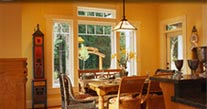Air Space: Dimensions and their sound properites
Source Post: http://www.replacement-windows.com/windowbb/viewtopic.php?p=5647Size matters - well, width and thickness anyway.
The wider the airspace between two lites of glass in a window system, the better the sound performance. A narrow airspace between two lites can actually enhance the sound - almost something of a megaphone effect.
The complaint that new windows can be actually "less quiet" than the old windows that they replaced can be quite valid. Mike gave a perfect example of why this can be true.
First, this was not a "single pane" window system. As modified it was a dual pane - although the panes were not mechanically linked.
Obviously, from the description, this "dual pane" was tight...there was no air (or sound) leakage around this set up. Also, the airspace between the original interior windows and the storms was probably a couple of inches wide, as well - ideal for attenuating unwanted sounds.
If someone wanted to design a "sound resistant" window system, then this particular construction, as described, would have made an ideal example...but, also as Mike said, it sure as heck wasn't a practical or comfortable living arrangement.
If a person has single or dual pane windows and needs additional sound protection, adding storm windows can help a great deal. But, with the caveat that the storms and the original windows have to be tight.
Loose windows pass sound.
If the orginal windows can be tightened and the storms are installed correctly (there's that "I" word again), then the air space that is created between the storm and the original window can help to prevent unwanted sounds from entering the home.
I only have a few minutes this morning, and while I will continue later (because I think this is fun!)...but, just to confuse matters further I am going to drop a few numbers and let everyone reading this ponder how potentially complicated noise reduction really can be...
I have discussed sound transmission loss in other posts...and without going into dB (at the moment) and how to use it, well, imagine a given dB (loudness level) and how different arrangements of glass affect this given loudness at different frequencies....
hope this makes sense...
1/8" glass, 1/4" airspace. 1/8" glass has a loss of 26dB at 100hz. But at 400hz, the loss is only 19dB. But at 2500hz, the loss is 46dB.
(Loss is a good thing - it describes how much quieter it will be)
1/4" x 1/2" air space x 1/4" has a loss of 29dB at 100hz, 31dB at 400hz, but only 36dB at 2500hz...so, this make up appears better at lower frquencies but not at higher when compared with the thinner glass and narrower airspace?
Well, at 5000hz, the 1/8" with narrower space has a 45dB loss while the 1/4" with wider airspace has a 58dB loss...confusing yet?
And finally, the 1/8" version has an STC of 28, while the 1/4" has an STC of 35.
Source Post: Window Options and Noise Control
http://www.replacement-windows.com/windowbb/viewtopic.php?p=5647
Posted: Fri Feb 03, 2006 8:50 am




 Call us at
Call us at


